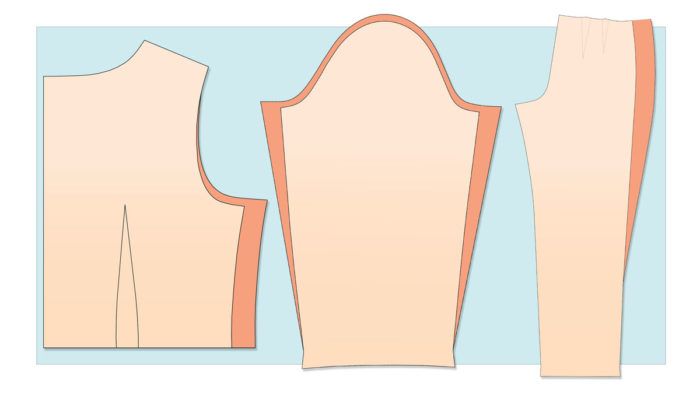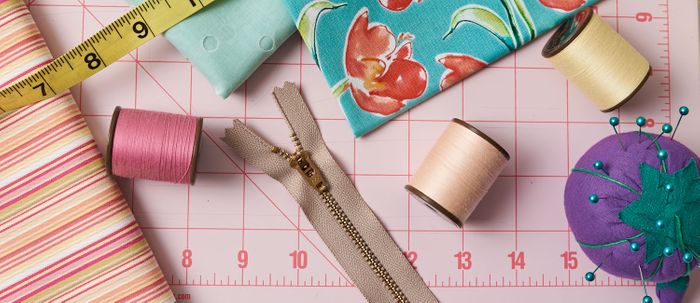Fitting a Curvy Figure
First steps to garments that complement your shape
Few sewers have an easy time of getting an ideal garment fit. If your measurements aren’t represented in the patterns you like, you may feel defeated before you begin. However, scaling standard-size patterns up to fit a curvy shape is possible, and it’s well worth the effort. With simple pattern adjustments, you can have clothes that fit you comfortably and reflect your personal style.
You’ll start by taking a set of body measurements, which you’ll then compare to the pattern you’d like to sew. Add—or subtract—width and length to make the pattern echo your dimensions. Then consider your ease needs and preferences to ensure that the garment fits and drapes as intended.
These changes bring a pattern into conformity with your overall size: You’ll be able to fit into the garment and have room to breathe and move. However, every body shape is unique, and you may want to fine-tune the pattern after making a test garment.
Once you’ve made the initial adjustments, feel free to tweak the fit and refine the details. In the upcoming Threads #209, June/July 2020 issue, I’ll share construction techniques to make plus-size garments that last longer and are more comfortable. With information on fitting and sewing for plus sizes, you can have a wardrobe you love to wear.
Take your measurements
Work from easy-to-locate anatomical points, without marking the body. These measurements are useful for adjusting commercial patterns but not necessarily for drafting patterns. You can download tables for recording your measurements here.

Prepare for accuracy
Dress right. Wear the undergarments and heel height you’ll wear with the garment you plan to sew.
Stand naturally. Don’t lock your knees or suck in your stomach.
Mark your waist. Tie a narrow ribbon around your…
Start your 14-day FREE trial to access this story.
Start your FREE trial today and get instant access to this article plus access to all Threads Insider content.
Start Your Free TrialAlready an Insider? Log in





I can't really believe that Threads would run this article. It's naive, to say the least, to think that you can just add some bits to the sides of patterns and voila, you will have a garment that fits. Will this work on a six gore skirt? Maybe. But a bodice? If you have a F cup bust and the pattern was drafted for a B, as so many are, simply widening it will produce a weird tent. As someone who has been altering patterns to fit her curvy shape for more than a decade, I'm here to say that telling people "just make the largest size bigger" is terrible advice. I'm very disappointed in you, Threads.
HI, TigerB,
This article is intended as a starting point, not a full exploration of the many ways a pattern can be fitted to a curvy figure. We know that every figure is different, and each person will need to address her own specific fit issues. The idea is to start by adjusting the pattern to accommodate the fuller body areas, after which further refinements are likely to be required. The articles listed on the last page offer methods and alternatives for getting a truly custom fit, once the overall size has been achieved through basic widening and lengthening techniques. Threads also has many articles on full-bust adjustments—more than we could fit in that box on the last page. Our goal was to make sure curvy sewers are not put off by the fact that a particular pattern might stop a couple of inches short of their personal measurements; that should never be an obstacle to sewing success.
Carol Fresia, Threads Senior Technical Editor
I read the PDF and it said to go to your website to print the measurement sheet for curvy figures. I am not sure where to find that link. Would you please let me know how to find that chart? Thanks so much.
Click on the word "here" in the "Take your measurements" paragraph in the post above; that will take you to the page where you can download the tables.
Carol J. Fresia, Threads Senior Technical Editor
Could you do an article for sewing for your 'round' husband as well? Or a link to one that is all ready published. Thank you very much for the tips and techniques
Hi!
We're working on getting some content for fitting men, including altering ready-to-wear. Meanwhile, you could take a look at David Page Coffin's book, Sewing Shirts with a Perfect Fit. He approaches the task through draping--which sounds complicated but is a more intuitive way to fit a body that doesn't match a standard pattern size.
Good luck!
Carol Fresia, Threads Senior Technical Editor